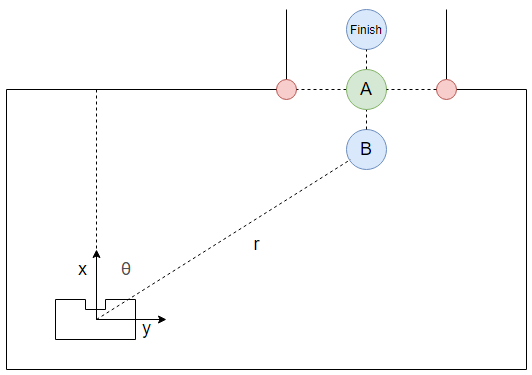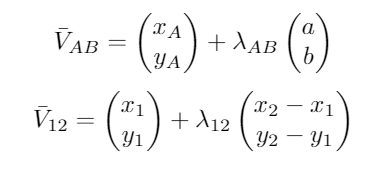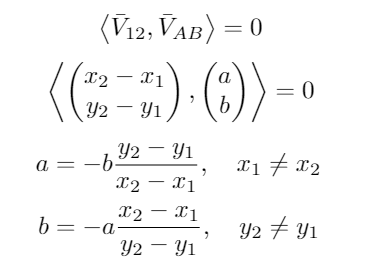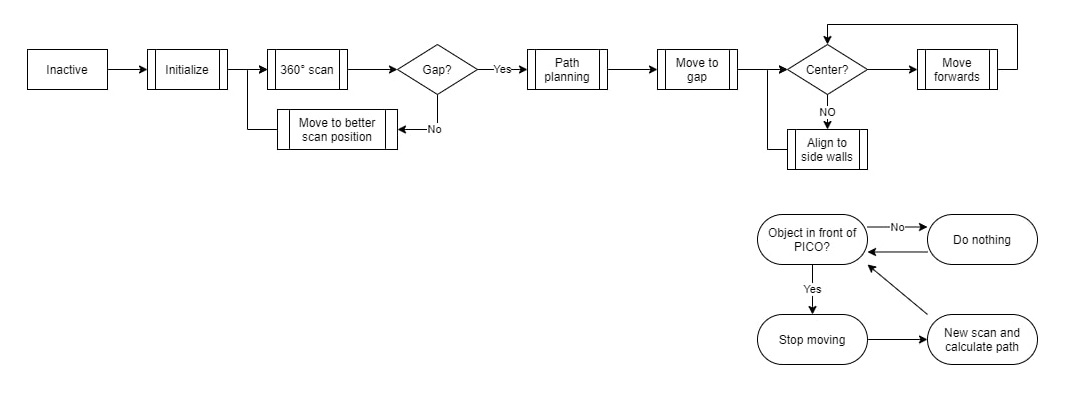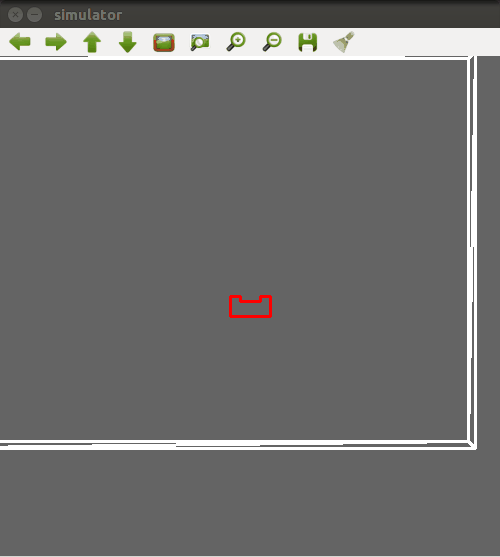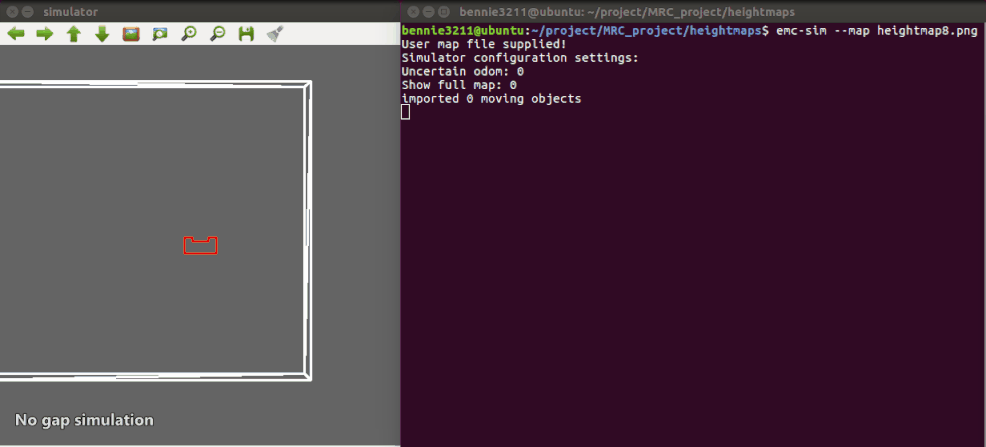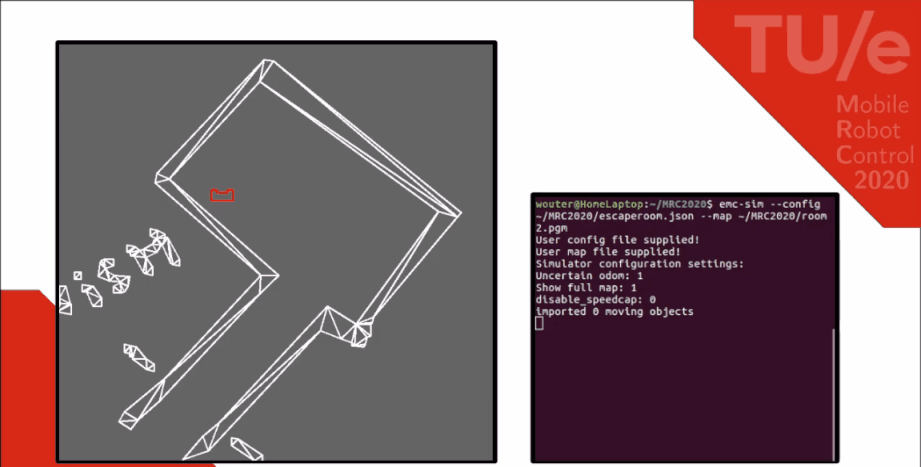Mobile Robot Control 2021 Group 4: Difference between revisions
TUe\20174546 (talk | contribs) No edit summary |
TUe\20174546 (talk | contribs) No edit summary |
||
| Line 5: | Line 5: | ||
= Group Members = | = Group Members = | ||
Luuk Verstegen - 1252488 | |||
Bob Bindels - 1246348 | |||
Stijn van den Broek - 1252011 | |||
Lars van Dooren - 1249169 | |||
Tjeerd Ickenroth - 1232296 | |||
Revision as of 14:54, 29 April 2021
Group Members
Luuk Verstegen - 1252488
Bob Bindels - 1246348
Stijn van den Broek - 1252011
Lars van Dooren - 1249169
Tjeerd Ickenroth - 1232296
Introduction
This Wiki-page reports the progress made by Group 1 towards completion of the Escape Room Challenge and the Hospital Challenge. The goal of the Escape Room Challenge is to escape a rectangular room as fast as possible without bumping into walls. The goal of the Hospital Challenge is to deliver medicines from one cabinet to another as fast as possible and without bumping into static and dynamic objects. This year, due to COVID-19, all meetings and tests are done from home. The meeting schedule is shown at the end of the wiki. The software for the autonomous robot (PICO) is written in C++ and applied to a simulation environment since there has been no interaction with PICO. The simulation environment should represent the real test as closely as possible and therefore the information on this page should be applicable to the real test.
Design document
In order to get a good overview of the assignment a design document was composed which can be found here. This document describes the requirements, the software architecture which consists of the functions, components and interfaces and at last the system specifications. This document provides a guideline to succesfully complete the Escape Room Challenge.
Escape Room Challenge
The Escape Room Challenge consists of a rectangular room with one way out. PICO will be placed on a random position on a map which is unknown to the challengers before taking the challenge. PICO should be able to detect the way out by itself using the Laser Range Finder (LRF) data and drive out of the room without hitting a wall using its three omni wheels.
To create a solid strategy a number of options have been outlined. Two solid versions were considered; wall following and a gap scan version. After confirming that the gap scan version can, if correctly implemented, be a lot faster than following the wall, this option was chosen. Wall following does not require much understanding of the perception of PICO. By constantly looking at the wall and turning if a corner is reached, PICO will move forward as soon as no wall is visible in front of it indicating that the corridor is found. One other reason to use gap detection over wall following as a strategy is that the gap detection and moving to certain targets can later on be used in the Hospital Challenge. In the Hospital Challenge multiple rooms are present, objects are placed in the rooms and cabinets have to be reached which make wall following unapplicable.
The code is divided in multiple parts, or functions, which work together to complete the task. These functions are separated code-wise in order to maintain a clear, understandable code. Next, the state machine of PICO is elaborated. Finally, the simulations will be discussed together with the result of the Escape Room Challenge.
Functions
Finding walls and gaps
Using the LRF, data points are obtained. To differentiate between the walls and the exit a least squares regression line algorithm has been written. This algorithm fits a line over all found data points in order to find a wall in the field of view (FOV) of the LRF. By connecting the walls together it can be possible that a gap occurs, which will be saved into the global reference frame. To collect the data, PICO starts with a 360 degree FOV rotation, while doing so collecting all gaps. When the scan stops, all the collected gaps are checked based on some criteria to see if it is an exit and if it is the best exit possible and, if needed, fixed (straightened based on the adjacent walls). This function is also used in the Hospital Challenge and elaborated in the section Perception.
Path planning
To let PICO move from the start location to the exit, a path was generated for PICO to follow. This path consisted out of two points, a pre target (denoted as target B) before the exit gap and a target in the center of the gap (denoted as target A). See Figure 1. This section describes how these points were computed.
If a gap has been found by PICO, the corners of this gap are obtained. From this, target A can easily be computed by taking the average in both x and y direction. Target B is then placed perpendicular to the gap on a distance of 0.4 meters, which is the width of PICO. This is done to prevent PICO from attempting to drive to his target through a wall. Target B was computed as follows. First, the gap and the line between points A and B were denoted as a vector representation
Then, a and b were computed. Since it is known that the vectors are orthogonal, the inner product should be zero, resulting in
Depending on the values of the x and y coordinates of the corners of the gap, either a or b was set to the value 1 in order to compute the other value. With a and b known, the direction of the vector AB is known. The length of this vector is also known, hence equating the two norm of the vector to the length of the vector results in
After these computations are completed, two possible locations for point B can be obtained. One before and after the gap. To determine the correct point, the distance from PICO to both points was computed. The point with the smallest distance will always be the point before the gap and thus the correct point B. Note that this will hold only when the room from which PICO needs to escape is a rectangle or when the corners of the gap are obtuse angles.
Potential field corridor
When PICO drives in the corridor, PICO starts to monitor the left and right wall to center itself between the walls of the corridor while moving towards the finish line. This is done using proportional control.
State machine
In Figure 2, the flow chart is depicted which starts at 'Inactive' and ends at 'Move forwards' until PICO stops.
The first step that will be executed is the 'Initialize' step. This step will be used to clear and set all variable values (the odometry data from the wheels as well as the LRF data) to the default state from which it will continue to the '360° scan', where using the LRF data all walls and possible gaps are detected. In this scan all LRF measurements will be mapped into wall objects if obtained data points connect. When data points do not connect, a gap occurs which can be a possible exit or a faulty measurement. When the scan can not find any gaps in the walls, PICO will move 1 meter to the furthest point measured in the scan and performs a new scan. If, for any reason, PICO tends to walk into a wall, the robot will move backwards and starts a new scan.
The next step 'Gap?' is checking if the gaps found can be considered as an exit. If no gaps meet the specifications of a gap, the next step will be 'Move to better scan position' and PICO will redo the previous steps. If a gap meets the requirements of the exit, then PICO will move on to ‘Path Planning, which will be executed to calculate the best possible way to the exit. When the path is set the following step will be 'Move to gap'.
The final step will be 'Center?' which will center the robot in the corridor of the exit to prevent that incorrect alignment with the exit will result in a crash with the walls.
Parallel to this flow PICO will continuously keep track of objects with the laser range finder. Whenever a object is detected in a specific range of the robot a flag will be thrown. This flag can be used to update the path planning, which will prevent crashes when the robot is heading in the wrong direction.
Simulation
The result of the strategy and the implemented functions is shown in Figure 3 where one can see that a gap is detected. PICO moves to a point in front of the opening and rotates towards the opening. While driving through the corridor, PICO keeps its distance to the walls.
In Figure 4 one can see how PICO behaves if no gaps are detected. PICO keeps on moving 1 meter from its scan location to scan again.
Escape Room Challenge results
The challenge attempt can be seen in Figure 5. As can be seen in the scanning, the robot rotates in a smooth counterclockwise rotation in which the gap detection algorithm detects the exit. After validation of the gap, a pre-target and target are placed in relation to the detected gap location. However, the movement towards it went wrong. Normally, the motion component of the software calculates the smallest rotation between the angle of PICO and the pre-target & target of the gap. During the development and validation of the written software in the simulator, this component worked as expected. However, during the challenge it emerged that the calculation did not work when comparing positive and negative angles. As a result, the calculation showed that a positive angle had to turn into the negative direction in order to reach its target. Because of this problem PICO started to rotate 270 degrees to the right instead of 90 degrees to the left. This problem came up 2 times, both after the 360 degrees scan and after reaching the pretarget.
Immediately in the first attempt PICO moved out of the room in 55 seconds. However, PICO decided to align itself with the reference angle using the largest rotation which costed a lot of time. In the end group 1 is proud of the result.
After the challenge we looked at this problem and applied a possible solution. If the simulation would be performed again with the right rotations the simulation time could be reduced to 25 seconds which would have resulted in a 2nd place during the challenge, instead of our 4th place that we were placed this time.
In summary, every software component worked fine without failing completely. However, after a bug fix in the motion component, everything works optimally without any known errors. The wall detection and motion software can be used for the hospital challenge and made usable with some additions without starting from scratch again.
